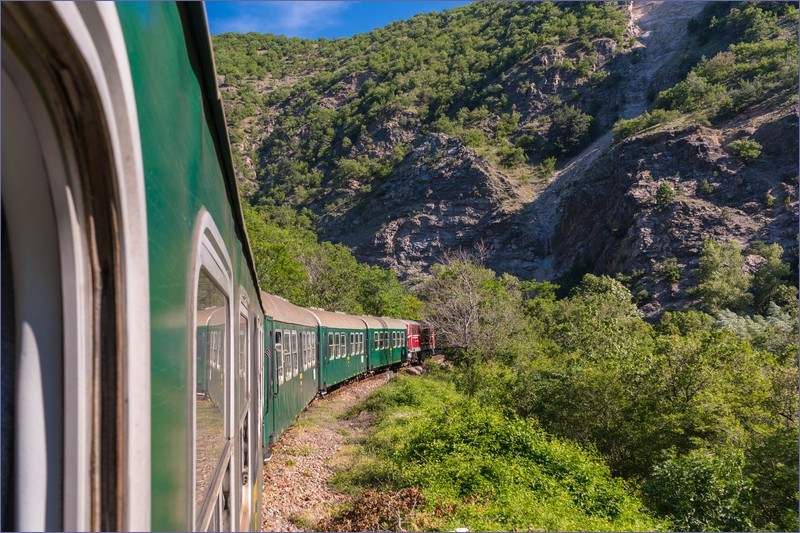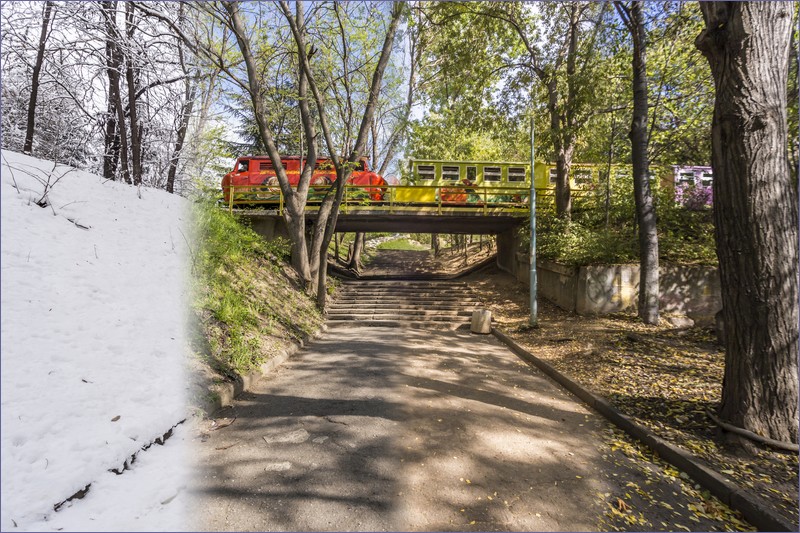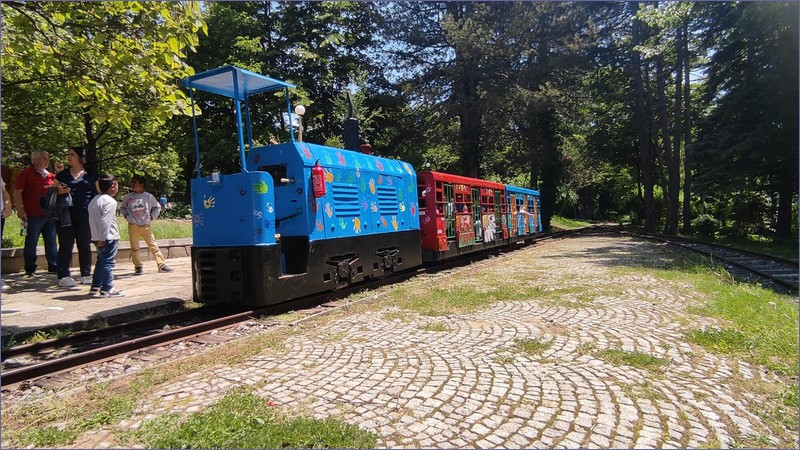There are three operational passenger narrow-gauge railways in Bulgaria. Most famous is scenic route from Septemvri to Dobrinishte with scheduled traffic. Trains from Septemvri to Dobrinishte run daily all year round. It is an unforgettable journey. Park railways in Plovdiv and Kardzhali run seasonally. A few narrow-gauge railways have been closed and dismantled in the past, for example Burgas – Pomorie and Yambol – Elhovo. Industrial narrow-gauge railway in salines near Burgas was also closed a few years ago.
Septemvri – Dobrinishte narrow gauge railway
Scenic and old-style narrow gauge railway from Septemvri to Dobrinishte deserves particular attention. The route is operated by Bulgarian State Railways (BDŽ). Four passenger trains in each direction run every day. The 125 km scenic journey through the picturesque valleys and gorges takes five hours. Trains run at an average speed of 22 km/h. You can admire the landscape from the train windows or take a photo at Avramovo Railway Station (1267.40 m), famous as the highest railway station in the Balkans.
Travelers describe the Septemvri – Dobrinishte line as a beautiful route with switchbacks, mountains, forests, waterfalls, and tunnels. The most beautiful section is Varvara – Velingrad, where the train first enters the canyon of the Chepinska River, then passes through tunnels along the riverbank. After the Cepina station, the train slowly climbs uphill to the Konstandovo station. Then, there’s a slight descent to Velingrad – an increasingly popular spa town.
Between the Sveta Petka and Avramovo stations (10 km), 17 tunnels were built. The elevation difference between the stations is 224 meters, and they are 3.5 km apart in a straight line. The tunnels are narrow, and in case of an accident or landslide, evacuating passengers would be problematic. Avramovo is a station located at an altitude of 1267 meters, making it the highest railway station in the Balkans.
According to various sources, this part of Bulgaria shows Muslim influences, and Pomaks – Muslim Slavs inhabiting this part of the Rhodope Mountains – can also be encountered.
Among the other stations and stops, the most interesting is Bansko – supposedly a very beautiful medieval town. In the winter season, many tourists come to Bansko and the surrounding area for skiing. Formerly, there was a locomotive and wagon graveyard near the station; I don’t have information on its current status.
The last six kilometers to Dobrinishte are a gentle descent with beautiful views.
Bansko and Dobrinishte are also excellent bases for hiking trails and the Pirin National Park.
The trains are composed of a diesel locomotive and old carriages. The carriages have Turkish-style toilets. There is no air conditioning; one should also prepare for significant temperature differences along the route and stock up on provisions, as the railway passes through sparsely populated areas, and there are no opportunities to purchase groceries at intermediate stations.
The train passes a number of tunnels, dense forests, climbs high up in the mountain and changes direction an eight times. You can meet Bulgarian villagers on the board for whom the train is the only means of transport to the larger towns, where they sell their agriculture products, do some shopping, do errands and go back home.
The railway was built in several stages between 1921 and 1945. There were plans to extend the line to Nevrokop, but due to difficult terain the plans were abandoned. The Varvara – Pazardzhik branch line (16 km) was closed in 2002.
If you are railway enthusiast you must ride this train while in Bulgaria.
Regular passenger services are hauled by diesel locomotive and has 2nd class old-style carriages. On state holidays, the Bulgarian State Railways launches special trains hauled by a steam locomotive manufactured in Chrzanow, Poland in 1949.

Children’s Railway in Plovdiv
One of Plovdiv’s lesser-known attractions is the children’s railway in the park at Youth Hill (Младежки хълм) in the city park. The construction of the children’s railway began on April 21, 1979, on the 35th anniversary of the establishment of the “Septemvrishte” pioneering organization. The railway line was built by pupils with the help of adults working voluntarily. The rolling stock fleet was delivered from the narrow-gauge railway line Kocherinovo – Rylski Monastyr, closed in 1954.
The railway was opened on 23 September 1979.
In 1997, the railway was closed, and its fate was uncertain. It reopened ten years later – in 2007. In 2013, the line was renovated.
Currently, the railway operates year-round – with six trains daily except on Mondays and Tuesdays when trains do not run. The route is 1090 meters long; the train passes over a bridge and through a fifty-meter tunnel. It was built to 600 mm gauge. The round trip takes 25 minutes, and the maximum speed is 8.5 km/h. The train consists of a locomotive and three wagons, capable of carrying a total of 50 passengers.

Children’s Railway in Kardzhali
The second children’s railway in Bulgaria was built in Kardzhali – a medium-sized industrial city in the southeast of the country. The children’s railway in Kardzhali is older than the railway in Plovdiv – it was put into operation on 30 September 1962, in the “Prostor” Park in the city center. The railway was a symbol of the city for decades. Later, like the children’s railway in Plovdiv, it fell into ruin after the political changes, and in the late 1990s, it was closed.
The reopening after the renovation of the line and the replacement of rolling stock took place in 2006. The length of the railway is 1210 meters. There is very little information about it.
You can reach Kardzhali from Dimitrovgrad by train from Stara Zagora – Podkova towards the Podkova station.
Children’s Railway in Kardzhali – official profile
Related articles:
Train travel in Bulgaria
Narrow-gauge railways by country
